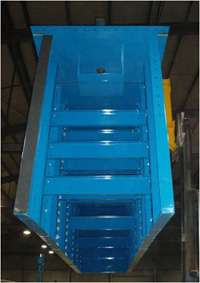Tsunami generator will help protect against future catastrophe

A unique wave-generating machine that mimics the activity of real-life tsunamis with unprecedented realism has been used successfully in an Oxfordshire laboratory.
The simulator has copied the behaviour of the first massive wave of the 2004 Boxing Day tsunami.
Developed and built with Engineering and Physical Sciences Research Council (EPSRC) funding, the tsunami generator will improve understanding of how tsunamis behave.
This will aid development of more effective evacuation guidelines for parts of the world potentially at risk from future tsunamis. It will also help improve the design of buildings in susceptible areas so they are better able to withstand the impact of such events.
The innovative new facility has been developed jointly by EPICENTRE (the Earthquake and People Interaction Centre), based at University College London, (UCL) and consulting engineers HR Wallingford, at whose headquarters it is located.
Mounted in a 45 metre-long wave channel, the tsunami generator uses a pneumatic (i.e. air-driven) system comprising a fan and control valves to suck up water into a tank and then release it in a controlled way. This makes the facility fundamentally different from all other wave simulators worldwide, which generally use pistons to produce waves by pushing at the water.
The new pneumatic technique has a range of advantages over a piston-based approach. In particular, tests by UCL researchers at HR Wallingford have shown that it can reproduce the draw-down phenomenon that is characteristic of 'trough-led' tsunamis where the sea is sucked out first before rushing back towards the shoreline.*
Within the wave channel, or 'flume', the waves created by the tsunami generator are directed over a model coastal slope, enabling their behaviour and effects to be studied in detail.
Specifically, tests with this facility will be used to enhance understanding of the water flows and forces unleashed by tsunamis. This will enable buildings and infrastructure in vulnerable parts of the world to be designed and built in ways that help them withstand these destructive events.
Moreover, because this understanding will make it easier to predict the behaviour of tsunamis at shorelines and when they move inland, the tsunami generator will make it possible to strengthen emergency and contingency planning at regional, national and individual community level.
"Although the basic concept is actually quite simple, this is the only facility that has ever been able to replicate the draw-down phenomenon in the laboratory", says Dr Tiziana Rossetto, EPICENTRE's Director. "We've already used the generator to mimic the 2004 Indian Ocean tsunami at 1:75scale. The data gathered should be validated and then made available to the scientific community within the next two years."
The tsunami generator was designed, built and tested between 2007 and 2009. EPSRC support was supplemented by additional funding from HR Wallingford and a studentship supported by consulting engineers Arup.
The aim is to make the tsunami generator available for use by other researchers from all over the world.

















